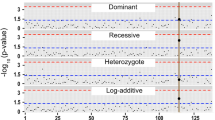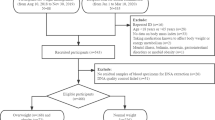Abstract
Objective:
Previous studies suggested that polymorphisms in the coding region of the preproghrelin were involved in the etiology of obesity and might modulate glucose-induced insulin secretion. We evaluated the association of a new variation, −604C>T, in the promoter region of the ghrelin gene, of Leu72Met (247C>A) and of Gln90Leu (265A>T), all haplotype-tagging single nucleotide polymorphisms (SNPs), with measures of insulin sensitivity in 1420 adult individuals.
Research methods:
The three SNPs were genotyped using ABI PRISM 7900 HT Sequence Detection System. We used multiple linear regression analysis for quantitative traits and THESIAS software for haplotype analysis.
Results:
We observed a protective effect exerted by Met72 variant of Leu72Met SNP on insulin resistance parameters; a significant decreasing trend from Leu/Leu to Leu/Met and to Met/Met homozygous subjects in triglycerides, fasting insulin levels and HOMA-IR index (P=0.02, 0.01 and 0.003, respectively), and, consistently, an increase in ghrelin levels (P=0.003) was found. A significant decrease from CC to TC and to TT genotypes in insulin levels and HOMA-IR index was also detected (P=0.00l for both), but only in subjects homozygous for Leu72, where the protective effect of Met72 was not present. The haplotype analysis results supported the data obtained by the evaluation of each single SNP, showing the highest value of insulin levels and HOMA-IR index in the −604c247c haplotype intermediate value in −604T247C and lowest value in −604C247A.
Conclusion:
Our observations suggest a protective role of the Met72 variant and of −604 T allele in modulating insulin resistance. These SNPs or an unknown functional variant in linkage disequilibrium could increase ghrelin levels and probably insulin sensitivity.
This is a preview of subscription content, access via your institution
Access options
Subscribe to this journal
Receive 12 print issues and online access
$259.00 per year
only $21.58 per issue
Buy this article
- Purchase on Springer Link
- Instant access to full article PDF
Prices may be subject to local taxes which are calculated during checkout
Similar content being viewed by others
References
Gnanapavan S, Kola B, Bustin SA, Morris DG, McGee P, Fairclough P et al. The tissue distribution of the mRNA of ghrelin and subtypes of its receptor, GHS-R, in humans. J Clin Endocrinol Metab 2002; 87: 2988.
Takaya K, Ariyasu H, Kanamoto N, Iwakura H, Yoshimoto A, Harada M et al. Ghrelin strongly stimulates growth hormone release in humans. J Clin Endocrinol Metab 2000; 85: 4908–4911.
Lawrence CB, Snape AC, Baudoin FM, Luckman SM . Acute central ghrelin and GH secretagogues induce feeding and activate brain appetite centers. Endocrinology 2002; 143: 155–162.
Kojima M, Hosoda H, Date Y, Nakazato M, Matsuo H, Kangawa K . Ghrelin is a growth-hormone-releasing acylated peptide from stomach. Nature 1999; 402: 656–660.
Tschop M, Smiley DL, Heiman ML . Ghrelin induces adiposity in rodents. Nature 2000; 407: 908–913.
Kamegai J, Tamura H, Shimizu T, Ishii S, Sugihara H, Wakabayashi I . Chronic central infusion of ghrelin increases hypothalamic neuropeptide Y and Agouti-related protein mRNA levels and body weight in rats. Diabetes 2001; 50: 2438–2443.
Chen HY, Trumbauer ME, Chen AS, Weingarth DT, Adams JR, Frazier EG et al. Orexigenic action of peripheral ghrelin is mediated by neuropeptide Y and agouti-related protein. Endocrinology 2004; 145: 2607–2612.
Tschop M, Weyer C, Tataranni PA, Devanarayan V, Ravussin E, Heiman ML . Circulating ghrelin levels are decreased in human obesity. Diabetes 2001; 50: 707–709.
Cummings DE, Purnell JQ, Frayo RS, Schmidova K, Wisse BE, Weigle DS . A preprandial rise in plasma ghrelin levels suggests a role in meal initiation in humans. Diabetes 2001; 50: 1714–1719.
Shiiya T, Nakazato M, Mizuta M, Date Y, Mondal MS, Tanaka M et al. Plasma ghrelin levels in lean and obese humans and the effect of glucose on ghrelin secretion. J Clin Endocrinol Metab 2002; 87: 240–244.
Saad MF, Bernaba B, Hwu CM, Jinagouda S, Fahmi S, Kogosov E et al. Insulin regulates plasma ghrelin concentration. J Clin Endocrinol Metab 2002; 87: 3997–4000.
Zhang JV, Ren PG, Avsian-Kretchmer O, Luo CW, Rauch R, Klein C et al. Obestatin, a peptide encoded by the ghrelin gene, opposes ghrelin's effects on food intake. Science 2005; 310: 996–999.
Ukkola O, Ravussin E, Jacobson P, Perusse L, Rankinen T, Tschop M et al. Role of ghrelin polymorphisms in obesity based on three different studies. Obes Res 2002; 10: 782–791.
Ukkola O, Ravussin E, Jacobson P, Snyder EE, Chagnon M, Sjostrom L et al. Mutations in the preproghrelin/ghrelin gene associated with obesity in humans. J Clin Endocrinol Metab 2001; 86: 3996–3999.
Korbonits M, Gueorguiev M, O'Grady E, Lecoeur C, Swan DC, Mein CA et al. A variation in the ghrelin gene increases weight and decreases insulin secretion in tall, obese children. J Clin Endocrinol Metab 2002; 87: 4005–4008.
Miraglia del Giudice E, Santoro N, Cirillo G, Raimondo P, Grandone A, D'Aniello A et al. Molecular screening of the ghrelin gene in Italian obese children: the Leu72Met variant is associated with an earlier onset of obesity. Int J Obes Relat Metab Disord 2004; 28: 447–450.
Poykko SM, Kellokoski E, Horkko S, Kauma H, Kesaniemi YA, Ukkola O . Low plasma ghrelin is associated with insulin resistance, hypertension, and he prevalence of type 2 diabetes. Diabetes 2003; 52: 2546–2553.
Lee MS, Wajnrajch MP, Kim SS, Plotnick LP, Wang J, Gertner JM et al. Autosomal dominant growth hormone (GH) deficiency type II: the Del32-71-GH deletion mutant suppresses secretion of wild-type GH. Endocrinology 2000; 141: 883–890.
Gruppuso PA, Gorden P, Kahn CR, Cornblath M, Zeller WP, Schwartz R . Familial hyperproinsulinemia due to a proposed defect in conversion of proinsulin to insulin. N Engl J Med 1984; 311: 629–634.
Expert Committee on the Diagnosis Classification of Diabetes Mellitus. Report of the Expert Committee on the Diagnosis and Classification of Diabetes Mellitus. Diabetes Care 2000; 1: S4–S19.
Friedewald WT, Levy RJ, Fredrickson DS . Estimation of the concentration of low-density-lipoprotein cholesterol in plasma without use of the preparative ultracentrifuge. Clin Chem 1972; 18: 499–502.
Gorden P, Lesniak MA, Hendricks CM, Roth J . ‘Big’ growth hormone components from human plasma: decreased reactivity demonstrated by radioreceptor assay. Science 1973; 182: 829–831.
Matthews DR, Hosker JP, Rudenski AS, Naylor BA, Treacher DF, Turner RC . Homeostasis model assessment: insulin resistance and beta-cell function from fasting plasma glucose and insulin concentrations in man. Diabetologia 1985; 28: 412–419.
Mager U, Kolehmainen M, Lindstrom J, Eriksson JG, Valle TT, Hamalainen H et al. Finnish Diabetes Prevention Study Group. Association between ghrelin gene variations and blood pressure in subjects with impaired glucose tolerance. Am J Hypertens 2006; 19: 920–926.
Trégouet DA, Escolano S, Tiret L, Mallet A, Golmard JL . New algorithm for haplotype based association analysis: the Stochastic-EM algorithm. Ann Hum Gen 2004; 68: 165–177.
Poykko SM, Kellokoski E, Horkko S, Kauma H, Kesaniemi YA, Ukkola O et al. Low plasma ghrelin is associated with insulin resistance, hypertension, and he prevalence of type 2 diabetes. Diabetes 2003; 10: 2546–2553.
Broglio F, Arvat E, Benso A, Gottero C, Muccioli G, Papotti M et al. Ghrelin, a natural GH secretagogue produced by the stomach, induces hyperglycemia and reduces insulin secretion in humans. J Clin Endocrinol Metab 2001; 10: 5083–5086.
Adeghate E, Ponery AS . Ghrelin stimulates insulin secretion from the pancreas of normal and diabetic rats. J Neuroendocrinol 2002; 7: 555–560.
Acknowledgements
This work has been supported in part by a grant of the Ministry of Health (ICS 030.6/RF00-49) and by a grant of Ministry of University and Research (MIUR 2003 2003061834_004).
Author information
Authors and Affiliations
Corresponding author
Rights and permissions
About this article
Cite this article
Zavarella, S., Petrone, A., Zampetti, S. et al. A new variation in the promoter region, the −604 C>T, and the Leu72Met polymorphism of the ghrelin gene are associated with protection to insulin resistance. Int J Obes 32, 663–668 (2008). https://doi.org/10.1038/sj.ijo.0803766
Received:
Revised:
Accepted:
Published:
Issue Date:
DOI: https://doi.org/10.1038/sj.ijo.0803766
Keywords
This article is cited by
-
Distribution and effect of ghrelin genotype on plasma lipid and apolipoprotein profiles in obese and nonobese Chinese subjects
Hormones (2021)
-
Leu72Met polymorphism of GHRL gene decreases susceptibility to type 2 diabetes mellitus in a Mexican population
BMC Endocrine Disorders (2020)
-
Association of −604G/A and −501A/C Ghrelin and Obestatin Prepropeptide Gene Polymorphisms with Polycystic Ovary Syndrome
Biochemical Genetics (2018)
-
Heterozygosity for the rs696217 SNP in the Preproghrelin Gene Predicts Weight Loss After Bariatric Surgery in Severely Obese Individuals
Obesity Surgery (2017)
-
Association of A-604G ghrelin gene polymorphism and serum ghrelin levels with the risk of obesity in a mexican population
Molecular Biology Reports (2017)



